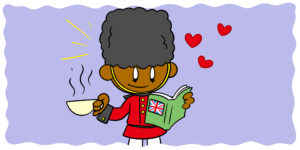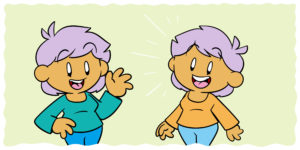Hello, reader. How have you been? Ah, good. Yeah, I’ve been great. Anyway, in this article we’ll be discussing why boring scenes start with one character greeting another. Whether ‘hey’, ‘hi’, or ‘salut’, looking out for greetings can be a great way to detect that your dialogue isn’t quite ready for print. Here’s why.
Hello Operator
In real life, it’s likely that whatever you’re talking about, you greeted the other member of the conversation before you began. In that sense, writing a ‘hello’ into your dialogue holds with the strictures of realism. The problem is that, in most circumstances, that’s about all it does.
Of course, there’s the rare fictional situation where a greeting adds value. If you need to exposit a relationship, for example, a greeting can offer a natural opportunity to deliver that information. In the theoretical extract of phone-call dialogue below, a quick greeting gives both characters an opportunity to quickly and efficiently deliver backstory:
“Hello, Doctor Chione Tannous speaking.”
“Hi Dr. Tannous, this is Roseanne Miller. We met at the Virology Conference in Austin.”
In cases like this, a greeting can pull its weight, but it’s still a good idea to interrogate such moments when editing your own work. Is the beginning of dialogue really the best moment to directly communicate who one character is to another? Sometimes, the answer is yes, but often this is just the easiest way to get that information out in the open, and it may not justify the drawbacks.
Having characters introduce themselves can be an efficient way to handle exposition.Click To TweetHello from the outside
For many authors, ‘hello’ crops up so often because it’s the chronological beginning of a scene. It’s the point at which an interaction began, and since an author needs to decide when to start depicting that interaction, the greeting offers itself as an obvious candidate.
The problem is that a greeting is rarely the point that most effectively communicates what an interaction is about. It takes a while for real discussions to get underway, to become engaging and shape their eventual focus, and that little while can be some truly dull reading. Instead, it’s generally preferable to begin things in medias res.
‘In medias res’ means ‘into the middle of things’, and it’s another way of phrasing that classical writer’s mantra, ‘start with the action’. Of course, this doesn’t necessarily refer to physical action. Instead, it means that an author should begin a scene with reference to what that scene’s about. In less polite terms, ‘get to the point’.
There are a lot of reasons that so many authors swear by this idea as an abiding truth. Cynical writers might cite their readers’ attention spans, but the truth is that it’s just more engaging, informative communication.
When we discuss what a scene is ‘about’, we don’t necessarily mean how it will end. Rather, we’re discussing tone, mood, and the context in which the reader is going to appreciate what follows – the emotional ‘point’ of a scene.
This is the chief problem when beginning with ‘hello’; it begins the interaction, but the interaction isn’t necessarily the scene. In such cases, ‘hello’ tricks authors into beginning their scene a few minutes before it has anything to communicate. It’s like describing the five minutes of sensible driving before a car chase or the sandwich a character makes and eats before their big presentation. It’s fluff, devoid of relevance, and it’s going to bore the reader.
The start of a discussion may not be the best place to start the scene in which that discussion appears.Click To TweetCan I say hello?
So, if ‘hello’ is so bad, what’s the alternative? Well, let’s begin with an example. Here’s the beginning of a scene with greetings included:
“Hi, Suzie,” said Dave, settling down in his seat. The diner was sparsely populated and, from the empty burger box at her elbow, it looked like Suzie had been there for a while.
“Hey Dave,” said Suzie. “Did you hear about the attack?”
This scene does have things to recommend it. The scene is set, the characters are introduced, and it didn’t take that long to get to the point. Despite this, it’s a scene that can easily be made better.
The first issue is that even though the greeting is included, it doesn’t exactly feel realistic. This doesn’t feel like two friends greeting each other – it feels like a perfunctory ‘greeting’ so that the scene can begin. In its current form, that’s not a major problem – it doesn’t ruin the scene – but it’s a problem we don’t need to have at all.
The next issue is that the start of the interaction makes the reader wait for the start of the scene. We’re here to discuss ‘the attack’, and while there’s nothing wrong with pacing out intrigue or excitement, that’s not what’s happening here. The reader isn’t reading this interaction thinking, ‘I wonder what they’re going to talk about! I can hardly wait’, they’re just slogging through the fluff, waiting for things to get interesting. Granted, it’s not a long slog in this case, but these moments are like barnacles; not only do they slow you down, but they just keep building up. So, what’s the better version?
“Did you hear about the attack?” asked Suzie.
Dave had barely sat down, but he could see by the empty burger box at her elbow that Suzie had been here for a while. The diner was sparsely populated, but her tone was hushed as if they were conspirators.
Here, the same information is shared – the narrative even looks back in time to Dave’s arrival – but now the scene setting has a purpose. The reader is left to contemplate what ‘the attack’ was, and the scene setting adds tension rather than just filling space. The reader is being teased because they already know the ‘point’ of the scene, and that means they’re an active participant in figuring out what’s happening.
Don’t begin a scene by boring the reader – there’s always a more creative solution.Click To TweetThe change here is minor, but by beginning at the start of the scene, not the beginning of the interaction, the act of communication is more successful. Reader and writer begin the scene in co-operation so that even withholding facts is part of a deliberate dance of understanding. If you need another example, go back to the start of this article and cut the first four sentences.
It’s not that ‘hello’ is toxic, but it is easy, and that makes it a beacon for moments that could benefit from another draft. Where you spot ‘hello’ in your writing, let it be a prompt to ask if your scene begins in a way that serves the reader. Did you begin by rewarding their interest, or did you begin where a stiff sense of chronology offered the path of least resistance?
Let’s say goodbye like we said hello
Of course, greetings aren’t a unique sign that a scene could be improved, but they’re useful flags in the difficult work of editing your own writing. They offer a reliable cue to ask specific questions, and that’s why they’re worth hunting down as you draft.
Happily, they also suggest another useful flag: ‘goodbye’. As with ‘hello’, ‘goodbye’ is often a sign that a scene hasn’t been pruned down to its most engaging shape. If you watch a lot of TV, you may have noticed the epidemic of rude phone calls, especially in dramas. In these phone calls, one character contacts another, gets the information they need, and then hangs up without saying ‘goodbye’. Why? Because ‘goodbye’ is boring, and TV has a far stricter relationship with time. TV writers don’t have seconds to dedicate to something that won’t engage the viewer, and this is one area where prose writers should take note.
Ever notice that TV characters hang up without saying ‘goodbye’? There’s a reason they’re so rude.Click To TweetA bad farewell tends to take one of two forms. The first is similar to a boring greeting; the scene goes on past its most engaging ending so the characters can say goodbye and agree to meet up some other time. The second does more damage – here, the writer senses that their ‘goodbye’ lacks worth so they decide to inject it with excitement. Characters rise from the conversation, walk to the door, stop in the threshold, and spit a mysterious or caustic farewell more suited to melodrama. In other words, authors force a dramatic goodbye that doesn’t suit the moment just because the boring goodbye doesn’t feel right.
It’s a good instinct but a bad response. What’s the alternative? Well, we already discussed that in The Better Way To End Your Scene (With Exercises).
Hello, I must be going
So, that’s why boring scenes so often start with ‘hello’. Do you have any examples or exceptions to share, or do you just want to say… hi? Let me know in the comments, and check out “Start With The Action!” – What It Means And When You Should Do It and Do You Really Need To Start At The Beginning? for more advice on this topic (but no more musical ‘hello’ references, because I used them all here).





